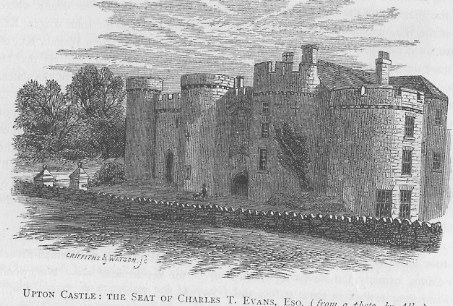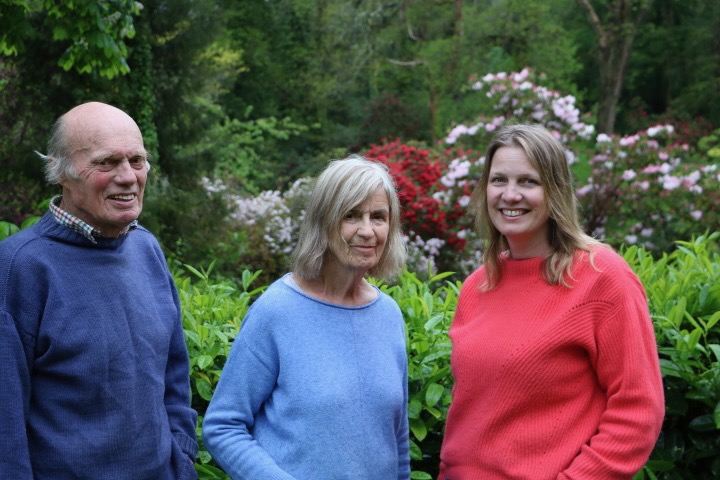1010 - 1160 AD
Christian burials in the area surrounding the Chapel (radio carbon dated by Time Team).
1092 AD
William II (Rufus) ordered castles to be built in Pembrokeshire with an eye on invading Ireland. These would have originally been in the form of wooden stockades with earthworks.
1093 AD
The Normans invaded Pembrokeshire from the sea lead by the Earl of Shrewsbury, building Pembroke castle soon after as a wooden ring work castle upon a rocky outcrop with a large cavern beneath, they then built a chain of motte and bailey castles and fortresses along and within the Landsker Line.
1100 AD
It is thought Upton Castle was built around this time to defend the river access to Carew castle the stronghold of Gerald de Windsor and Princess Nesta of Wales.
1112 AD
Griffri, Bishop of St Davids (died in 1112) purchased peace from Gerald de Windsor, perhaps for his lack of celibacy, by yielding up lands at Llanrian in Dewisland, Cenarth Mawer in Emlyn, Lawrenny and Ucceton.
1150 AD
Origins of the stone St Giles Chapel. The time team discovered evidence of an Apse, a typical feature of Norman Romanesque churches built in 12th century.
1188 AD
Existence of St Giles chapel at Upton is noted by Gireldis Cambrensis in his book The Journey Through Wales and Description of Wales.
1220 AD
The birth of Walter Malefant I, who married Alice De La Roche (c1216), the daughter of the powerful Norman/Flemish Marcher Lord Sir John de la Roche. No written record of Walter I residing at Upton exists, the Castle may have passed to the Malefants with this marriage or that of their son Walter II to Joan Fitz Henry descendant of Princess Nesta of Wales.
1258 AD
According to Annales Cambrice Walter Malefant I was killed fighting the Welsh at Kilgerran.
1280 AD
Marriage of Walter Malefant II (b1257) and Joan Fitz Henry (b 1255) descendant of Henry Fitz Henry, Illegitimate son of King Henry I and Princess Nesta of Wales.
1298 AD
David Malesent, witness to a charter with Henry Fitz Henry to the Dowery of Isabel De Anguulo on her marriage to William de Rupe . (British Museum Stone charter XXXII.14)
1324 & 1348 AD
1324 & 1348 Sir Walter Malenfant III held half a knight’s fee in Esse or Nash, of the value of 10 marks.
1362 AD
William Malefant died seised (in legal possession of) of the manors of Over Nash and Nether Nash worth 60s and further lands he owned jointly with his heiress wife. His Effigy and that of his wife Margret Fleming can be seen in the chapel.
1401 AD
A grant of burage (rent on land held from the king) in Tenby to Henry Malefant of Octon Esq.
1405 AD
Henry Malefant played a part in the battle against Owen Glyndwr who was fighting for Welsh independence. He was one of three commissioners appointed to raise funds to bribe Owen Glyndwr to stop attacks on Pembrokeshire and paid £12.8d into the fund.
1437 AD
Parliamentary rolls record upon the death Sir Thomas Malifant his wife Lady Margret was abducted at Upton by Lewis Leyston, her husband’s trusted servant, taken to Tythegston in Glamorgan and kept prisoner ’in a chamber within a strong tower’ for two days, threatening her with dire punishment unless she agreed to marry Lewis Leyston. Fortunately, she escaped and from a charter of 1441 it appears she held the Malefant Pembrokeshire estates for her life.
1469 AD
William, Earl of Pembroke was beheaded for his part in the battle of Banbury. In his will, written on the day of his execution, he expressed his wish that his daughter Jane be married to Edward Malephant of Upton.
1564 AD
Marriage of Alice Malephant and Owen ap Gruffydd. Upton passed, by marriage, to Owen ap Gryffed and later their descendants changed their name to Bowen. Rhys ap Owen of Upton Castle High Sherrif of Pembrokeshire.
1753 AD
On the 10th October Morris Bowen died aged 40.
1789 AD
Upton castle was bought for £7,000 by John Tasker Esq, a bachelor, of the East India Company, Master Attendant of the Port of Bombay, who probably built the walled garden.
1800 AD
On the death of Sir John Tasker, the estate devolved on his three nieces and eventually settled on Maria, a grand-niece who married firstly the Rev.Thomas Woods and, secondly, the Rev. William Evan, of Hook Norton.
1867 AD
Sir Henry Halford Vaughn, British historian and Regius professor of History at Oxford moved to Upton Castle, as tenant, with his wife Adeline Vaughn, Aunt of Vanessa Bell and Adeline Virginia Woolf.
1927 AD
Vice Admiral Tasker-Evans sold Upton to Stanley Neale, a ship owner from Cardiff. A keen plantsman, he was determined to make a special garden. The unique situation of Upton Castle with its acid soil and hidden valley providing shelter for plants, together with its proximity to the Gulf Stream made it the ideal environment in which to create his garden
1970 AD
Stanley Neale’s daughter, Joyce Skelton, inherited the property and continued the work of renewing and replanting.
It was at this time that the Pembrokeshire Coast National Park became involved with the maintenance of the gardens which were then opened to the public for the first time.
2007 AD
For the third time in 750 years Upton Castle was sold to the present residents Stephen and Prue Barlow. By the time Steve and Prue Barlow bought Upton Castle in 2007, The National Park had withdrawn their assistance and the gardens had become very neglected and in need of a major overhaul. A dedicated team of volunteers generously donate their time to make it possible to open the gardens to the public. With their valued help and support all can enjoy the beautiful gardens in the summer months.

